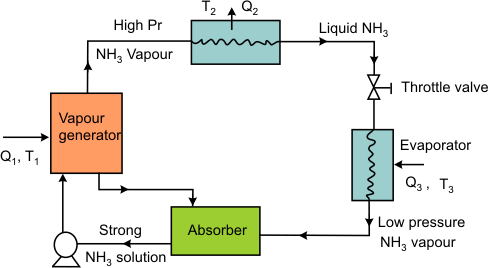Absorption Refrigeration System
The vapour absorption system is shown in Figure 31.4.

Figure 31.4
In the absorption refrigeration system, refrigeration effect is produced mainly by the use of energy as heat. In such a system, the refrigerant is usually dissolved in a liquid. A concentrated solution of ammonia is boiled in a vapour generator producing ammonia vapour at high pressure. The high pressure ammonia vapour is fed to a condenser where it is condensed to liquid ammonia by rejecting energy as heat to the surroundings. Then, the liquid ammonia is throttled through a valve to a low pressure. During throttling, ammonia is partially vapourized and its temperature decreases. This low temperature ammonia is fed to an evaporator where it is vapourized removing energy from the evaporator. Then this low-pressure ammonia vapour is absorbed in the weak solution of ammonia. The resulting strong ammonia solution is pumped back to the vapour generator and the cycle is completed. The COP of the absorption system can be evaluated by considering it as a combination of a heat pump and a heat engine (Figure 31.5).

Figure 31.5 Heat Engine
 |
(31.7) |
Heat Pump
 |
(31.8) |
or
 |
(31.9) |
now,
 |
(31.10) |
or,
 |
(31.11) |
|